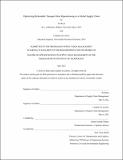| dc.description.abstract | The automotive industry is an exemplary leader in the use of returnable cases for the transportation of inbound freight. Their use reduces the need of expensive and expendable packing and contributes to lower greenhouse gas emissions. However, the utilization of returnable cases is hindered when there is high variability in demand and lead times that make the return process challenging. This imposes a network design challenge in which the flow must be analyzed and determined to guarantee delivery continuity. Focusing on this problem, this research deals with an expanded network that enables more possibilities for the transportation of returnable transport items. The results will measure the potential total costs reductions and the impact on greenhouse gas emissions that result from the new network design. With this motivation, we developed a series of single-objective mathematical models to obtain minimum costs and emissions targets. We then used goal programming on a bi-objective mixed-integer linear program to investigate the quantity and flows of returnable cases that minimized both costs and emissions targets obtained previously. The optimal solution is reached with a 3.4% decrease in costs, 1% increase in CO! emissions, and a 51% reduction in the use of expendable packing. | en_US |
